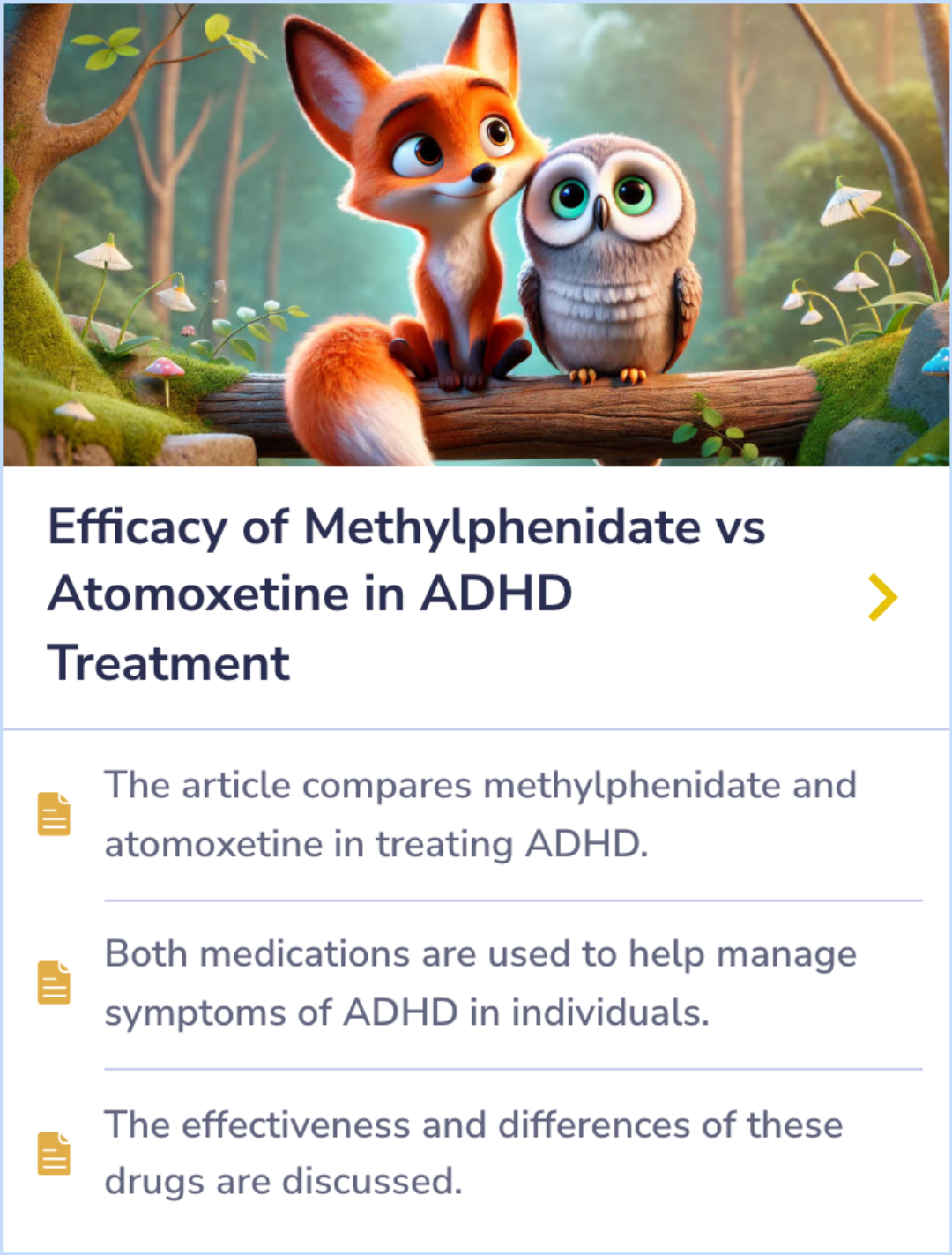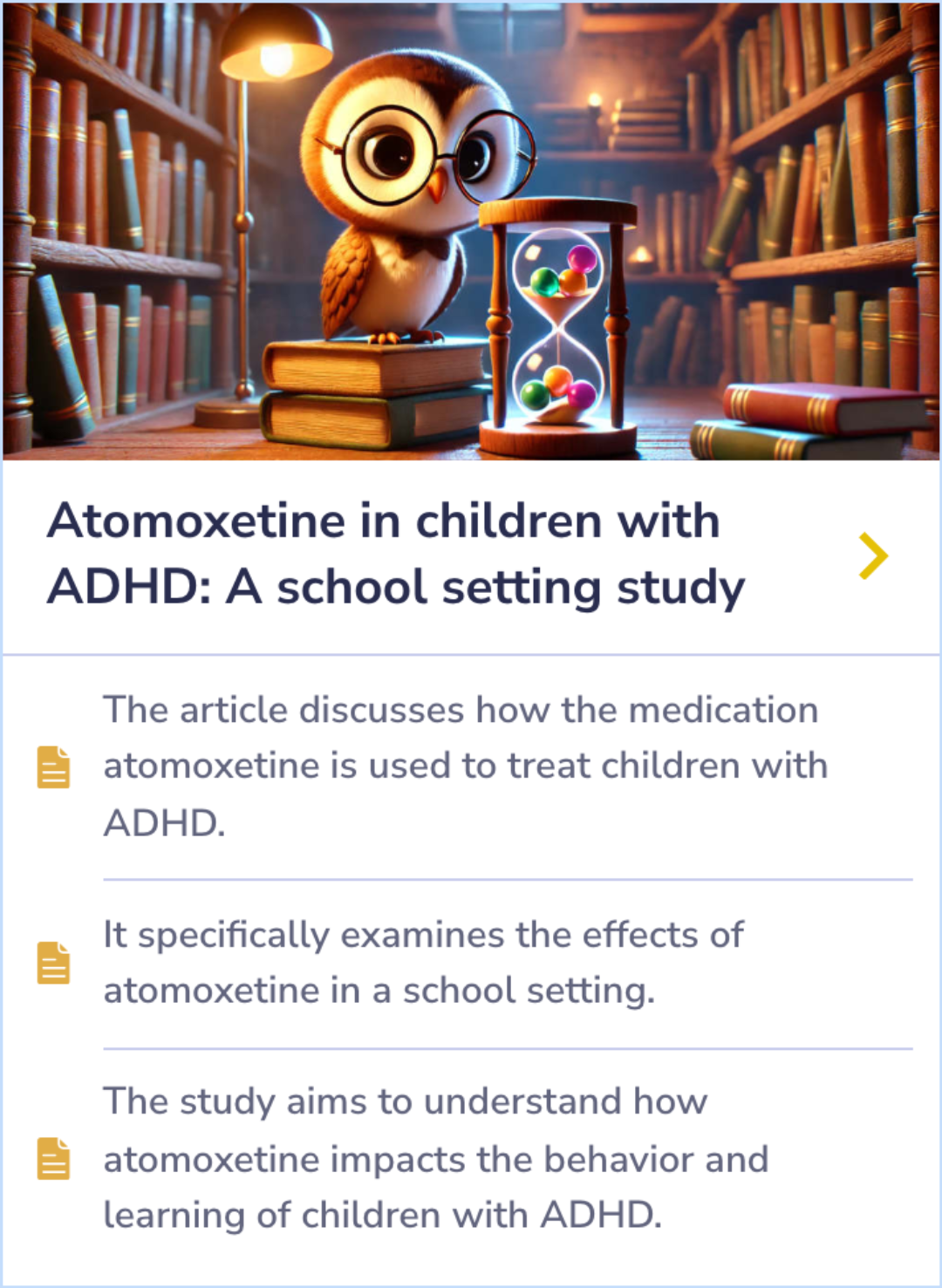Strattera Paper Database
Visual Abstract
Atomoxetine and methylphenidate treatment in children with ADHD: a prospective, randomized, open-label trial
Atomoxetine vs. Methylphenidate in ADHD
October 25, 2024
author
Kratochvil CJ, Heiligenstein JH, Dittmann R, Spencer TJ, Biederman J, Wernicke J, Newcorn JH, Casat C, Milton D, Michelson D
journal
J Am Acad Child Adolesc Psychiatry
Date Published
2002 Jul
Why link to a visual abstract?
What is a visual abstract?
Original
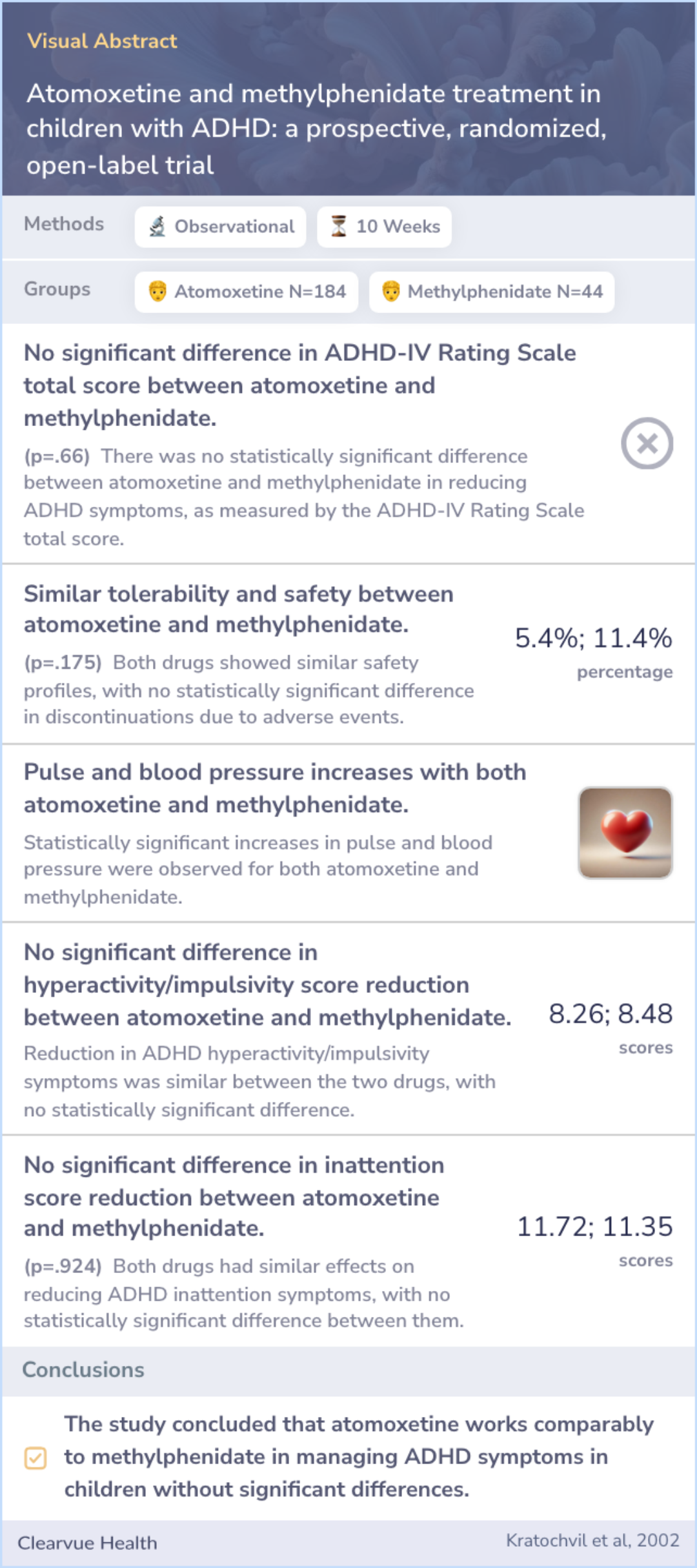
Study Summary
🔬
What They Studied
The study aimed to compare atomoxetine and methylphenidate for treating ADHD.
💡
What They Found
Both atomoxetine and methylphenidate effectively improved ADHD symptoms with no significant differences in outcomes.
📚
What This Means
The study shows atomoxetine works as well as methylphenidate in treating ADHD, aligning with the current understanding of ADHD treatment options that include both medications.
Study Summary
Study Overview
This study aimed to explore the effectiveness of atomoxetine as a treatment for children with ADHD compared to the more traditional stimulant, methylphenidate. It marked a significant step in addressing ongoing uncertainties about non-stimulant therapies in ADHD.
The findings showed that both medications led to similar improvements in ADHD symptoms and highlighted the importance of consistent assessments by experienced clinicians to ensure accurate evaluations in future studies.
The findings showed that both medications led to similar improvements in ADHD symptoms and highlighted the importance of consistent assessments by experienced clinicians to ensure accurate evaluations in future studies.
Abstract: background
To assess the comparability of atomoxetine, a new therapy for attention-deficit/hyperactivity disorder (ADHD) and methylphenidate. (Atomoxetine was originally called tomoxetine. The name was recently changed in order to avoid any potential confusion ...more

Preliminary Evidence
"These results are of interest from several perspectives."
Symptom Reduction
"Among children with DSM-defined ADHD, similar reductions in ADHD symptoms were seen in both the atomoxetine and methylphenidate treatment groups."
Importance of Consistent Assessment
"Another interesting aspect of this study is the use of an investigator-administered, semistructured interview of the parent, in addition to direct parent reports."
Study Summary
Methods
In this study, children diagnosed with ADHD were randomly assigned to receive either atomoxetine or methylphenidate over a period of 10 weeks. The effects of the treatments were evaluated using the ADHD-IV Rating Scale, a tool that helps measure ADHD symptoms.
This process of random assignment and open-label treatment ensured that neither the children nor the researchers knew in advance which medication was being administered, aiming to reduce bias.
This process of random assignment and open-label treatment ensured that neither the children nor the researchers knew in advance which medication was being administered, aiming to reduce bias.
Abstract: methods
Children with ADHD were randomized to open-label atomoxetine or methylphenidate for 10 weeks. Response was assessed with the ADHD-IV Rating Scale.

Study Summary
Results
The study involved 228 children, with 184 receiving atomoxetine and 44 receiving methylphenidate. Both medications led to significant improvements in symptoms, as judged by parents and clinicians. There was no clear difference in how effective each drug was based on the main scale used.
Additionally, both treatments had similar safety profiles, meaning that side effects were comparable. Discontinuation due to side effects was relatively low and similar between groups.
Additionally, both treatments had similar safety profiles, meaning that side effects were comparable. Discontinuation due to side effects was relatively low and similar between groups.
Abstract: results
Two hundred twenty-eight patients were randomized (atomoxetine n = 184, methylphenidate n = 44). Both drugs were associated with marked improvement in inattentive and hyperactive-impulsive symptom clusters as assessed by parents and investigators. No...more
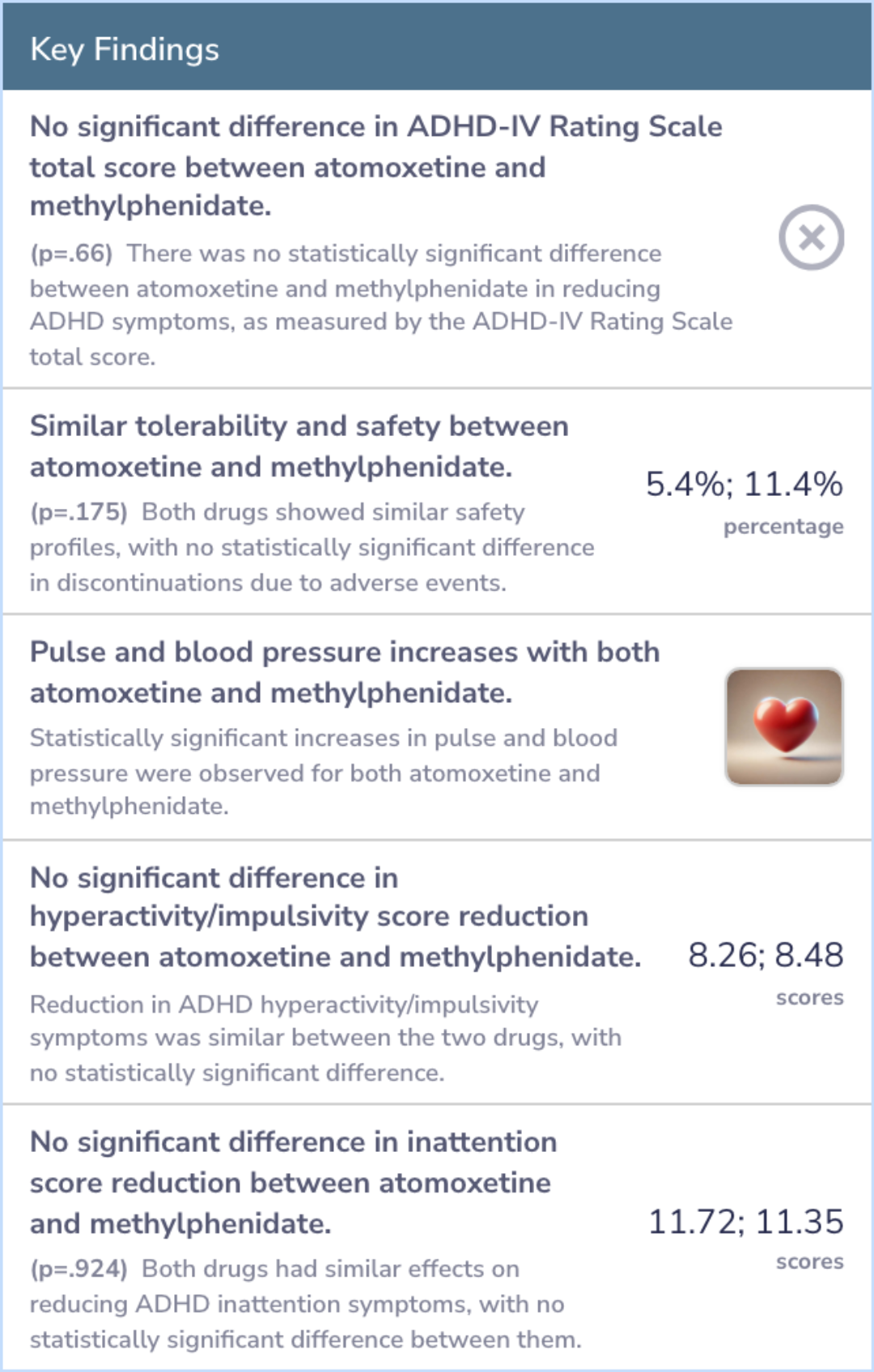
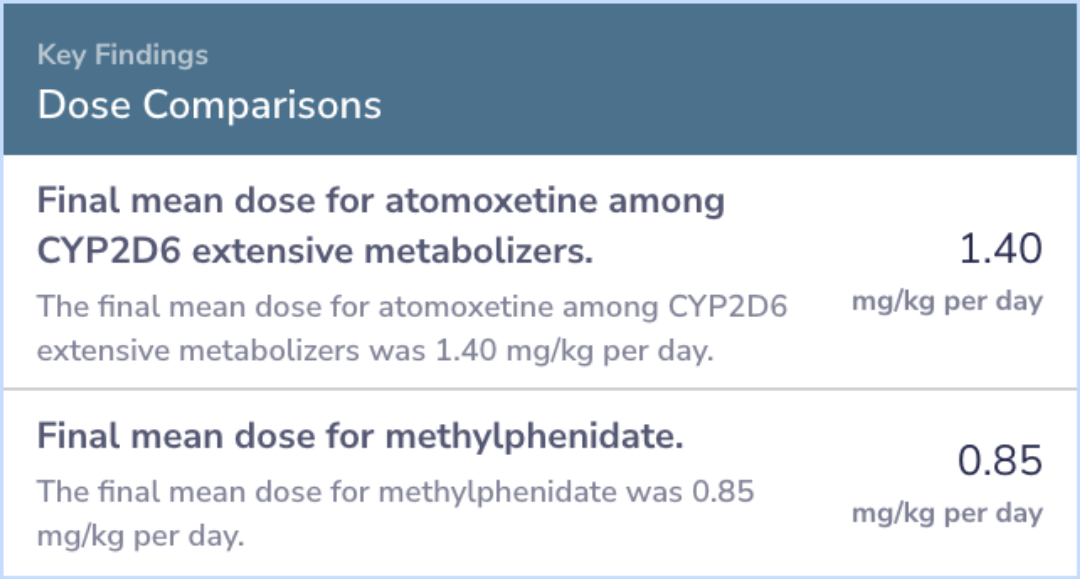
Study Summary
Conclusions
The findings suggest that atomoxetine is about as effective as methylphenidate in managing ADHD symptoms, offering similar therapeutic benefits. This suggests that both drugs could be viable options for treatment depending on individual needs and responses.
Further studies might be necessary to fully understand long-term effects and decide if one drug might be more suitable for particular subgroups of patients.
Further studies might be necessary to fully understand long-term effects and decide if one drug might be more suitable for particular subgroups of patients.
Abstract: conclusions
These data provide preliminary evidence that atomoxetine is associated with therapeutic effects comparable to those of methylphenidate.

Background Information
Patient Guide
⚙️
Atomoxetine's Mechanism of Action
Atomoxetine selectively inhibits norepinephrine reuptake, influencing dopamine in specific brain regions.
🧠
Comprehensive ADHD Treatment
Atomoxetine is part of a complete treatment plan including psychological, educational, and social support.
💊
Methylphenidate's Multi-Form Availability
Available in immediate, extended, and sustained-release forms, methylphenidate offers versatile administration.
🧠
Methylphenidate's CNS Stimulation
Enhances norepinephrine and dopamine levels by blocking their reuptake, aiding ADHD treatment.
👀
Risks and Monitoring
Both medications require monitoring for cardiovascular and psychiatric symptoms and growth effects in children.
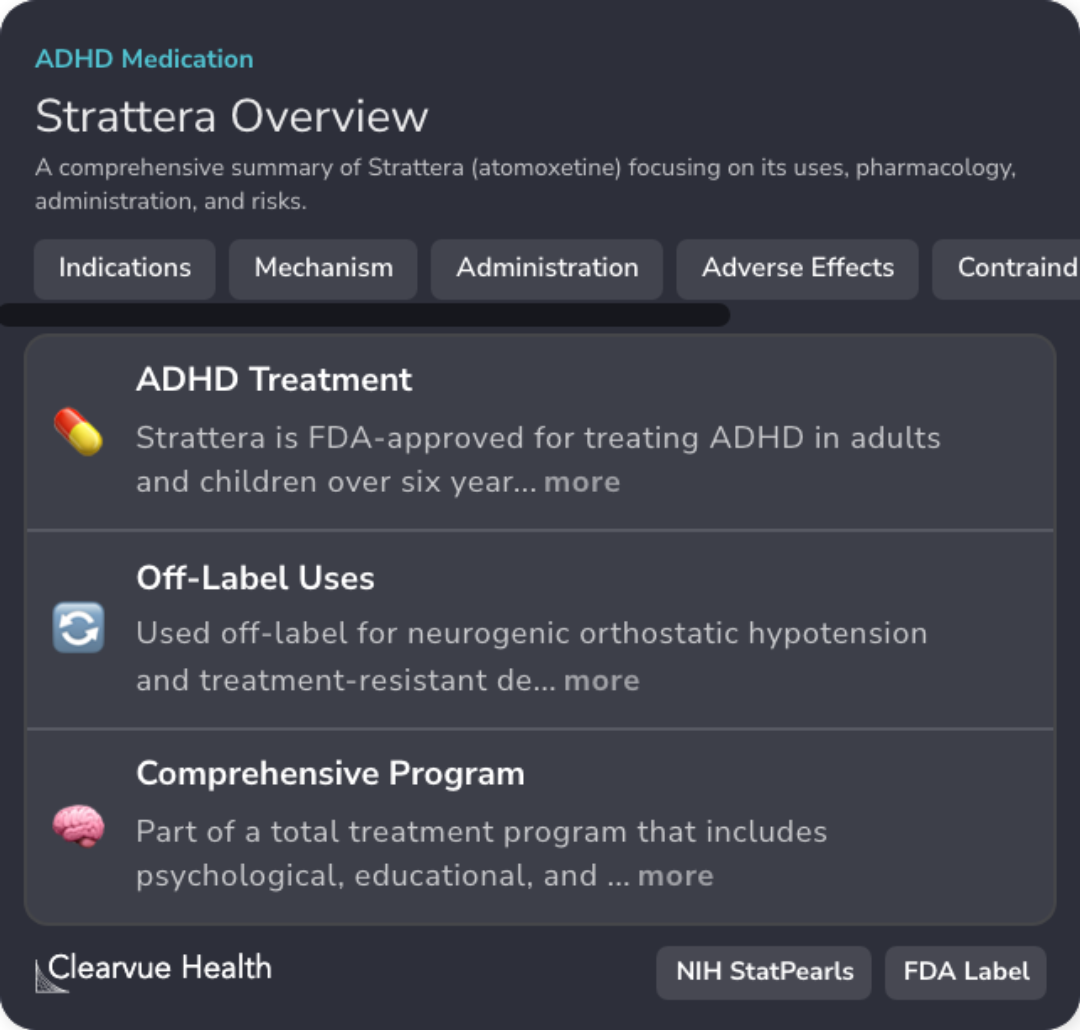
Professional Guide
Expert Opinion: Atomoxetine vs. Methylphenidate in ADHD
In light of comparable therapeutic effects shown in the abstract, it is relevant to note that atomoxetine, despite being effective, may take several weeks for a noticeable impact on ADHD symptoms, unlike stimulants.
While stimulants often show greater efficacy, atomoxetine stands out as the first non-stimulant approved for ADHD treatment, offering an alternative particularly when stimulants are unsuitable.
Furthermore, atomoxetine's metabolism can be influenced by genetic factors, impacting its bioavailability significantly.
While stimulants often show greater efficacy, atomoxetine stands out as the first non-stimulant approved for ADHD treatment, offering an alternative particularly when stimulants are unsuitable.
Furthermore, atomoxetine's metabolism can be influenced by genetic factors, impacting its bioavailability significantly.
Evidence Summary
Evaluating the Role of Methylphenidate and Atomoxetine in ADHD Treatment
The comparison between methylphenidate and atomoxetine reveals insights into their effectiveness in managing ADHD symptoms. Both drugs are widely used, but their roles in treatment may differ depending on the individual needs of the patient.
The focus is on understanding how each medication works and the nuances in their effects, providing a clear view of the potential benefits of each option for those managing ADHD symptoms.
The focus is on understanding how each medication works and the nuances in their effects, providing a clear view of the potential benefits of each option for those managing ADHD symptoms.
Evidence Summary
Understanding Atomoxetine's Safety and Side Effects in ADHD
Atomoxetine is highlighted as a viable ADHD treatment, offering a detailed comparison with other medications. It outlines common side effects patients might experience and dives into the safety profile of the drug. The overview provided in the article serves as a guide for those weighing treatment options.
The focus remains on what atomoxetine brings to the table, ensuring patients have clear expectations regarding its use in managing ADHD.
The focus remains on what atomoxetine brings to the table, ensuring patients have clear expectations regarding its use in managing ADHD.
Evidence Summary
Atomoxetine's Role in School: Impact on ADHD Support
This article explores a study on atomoxetine, used in treating children with ADHD in schools. It examines how the drug influences their behavior and learning, thus offering insights into treatment effects in an educational setting.
Atomoxetine is highlighted for its impact on helping children manage ADHD challenges, giving a glimpse into how medication can support learning and behavior improvements.
Atomoxetine is highlighted for its impact on helping children manage ADHD challenges, giving a glimpse into how medication can support learning and behavior improvements.

